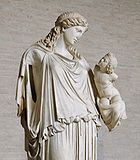
Cephisodotus the Elder
Encyclopedia

Ancient Greek sculpture
Ancient Greek sculpture is the sculpture of Ancient Greece. Modern scholarship identifies three major stages. They were used to depict the battles, mythology, and rulers of the land known as Ancient Greece.-Geometric:...
, perhaps the father or an uncle of Praxiteles
Praxiteles
Praxiteles of Athens, the son of Cephisodotus the Elder, was the most renowned of the Attic sculptors of the 4th century BC. He was the first to sculpt the nude female form in a life-size statue...
, one of whose sculptor sons was Cephisodotus the Younger
Cephisodotus the Younger
Cephisodotus, son of Praxiteles, brother of Timarchos and grandson of Cephisodotus the Elder. None of his work remains in originals, but in later, mostly roman copies. He was in a team with his brother a prolific sculptor of the latter part of the 4th century BC, especially noted for portraits, of...
.
The one noted work of his was Eirene
Eirene (Greek goddess)
Eirene, or Irene |Pax]]), one of the Horae, was the personification of peace, and was depicted in art as a beautiful young woman carrying a cornucopia, sceptre and a torch or rhyton. She is said sometimes to be the daughter of Zeus and Themis....
(Peace) bearing the infant Ploutos (Wealth), ca 380-370 BC, of which a Roman point copy
Pointing machine
A pointing machine is a measuring tool used by stone sculptors and woodcarvers to accurately copy plaster, clay or wax sculpture models into wood or stone....
exists at the Glyptothek
Glyptothek
The Glyptothek is a museum in Munich, Germany, which was commissioned by the Bavarian King Ludwig I to house his collection of Greek and Roman sculptures . It was designed by Leo von Klenze in the Neoclassical style, and built from 1816 to 1830...
, Munich (illustration, right) and fragments in various collections. The Eirene, commissioned by the city of Athens and set up on the Areopagus
Areopagus
The Areopagus or Areios Pagos is the "Rock of Ares", north-west of the Acropolis, which in classical times functioned as the high Court of Appeal for criminal and civil cases in Athens. Ares was supposed to have been tried here by the gods for the murder of Poseidon's son Alirrothios .The origin...
, was attributed to Cephisodotus by Pausanias
Pausanias (geographer)
Pausanias was a Greek traveler and geographer of the 2nd century AD, who lived in the times of Hadrian, Antoninus Pius and Marcus Aurelius. He is famous for his Description of Greece , a lengthy work that describes ancient Greece from firsthand observations, and is a crucial link between classical...
in the 2nd century AD.
Cephisodotus also made, as did his son, a figure of Hermes
Hermes
Hermes is the great messenger of the gods in Greek mythology and a guide to the Underworld. Hermes was born on Mount Kyllini in Arcadia. An Olympian god, he is also the patron of boundaries and of the travelers who cross them, of shepherds and cowherds, of the cunning of thieves, of orators and...
carrying the child Dionysus
Dionysus
Dionysus was the god of the grape harvest, winemaking and wine, of ritual madness and ecstasy in Greek mythology. His name in Linear B tablets shows he was worshipped from c. 1500—1100 BC by Mycenean Greeks: other traces of Dionysian-type cult have been found in ancient Minoan Crete...
, unless indeed ancient critics have made two works of one. He made certain statues for the city of Megalopolis
Megalopolis, Greece
Megalópoli is a town in the western part of the peripheral unit of Arcadia, southern Greece. It is located in the same site as ancient Megalopolis . "Megalopolis" is a Greek word for Great city. When it was founded, in 371 BC, it was the first urbanization in rustic and primitive Arcadia. In...
, founded by Epaminondas
Epaminondas
Epaminondas , or Epameinondas, was a Theban general and statesman of the 4th century BC who transformed the Ancient Greek city-state of Thebes, leading it out of Spartan subjugation into a preeminent position in Greek politics...
in 369 BC; Pausanias noted them in the principal temple there in the 2nd century AD.
Two heads that were long thought to be feminine and inserted in female busts, one formerly in the Lansdowne collection
Lansdowne House
Lansdowne House is a building to the southwest of Berkeley Square in central London, England. It was designed by Robert Adam as a private house and for most of its time as a residence it belonged to the Petty family, Marquesses of Lansdowne. Since 1935, it has been the home of the Lansdowne Club....
and the other in the Massarenti collection, Rome, now recognized to be of Apollo, were attributed to Cephisodotus by Dorothy Kent Hill in 1974.

